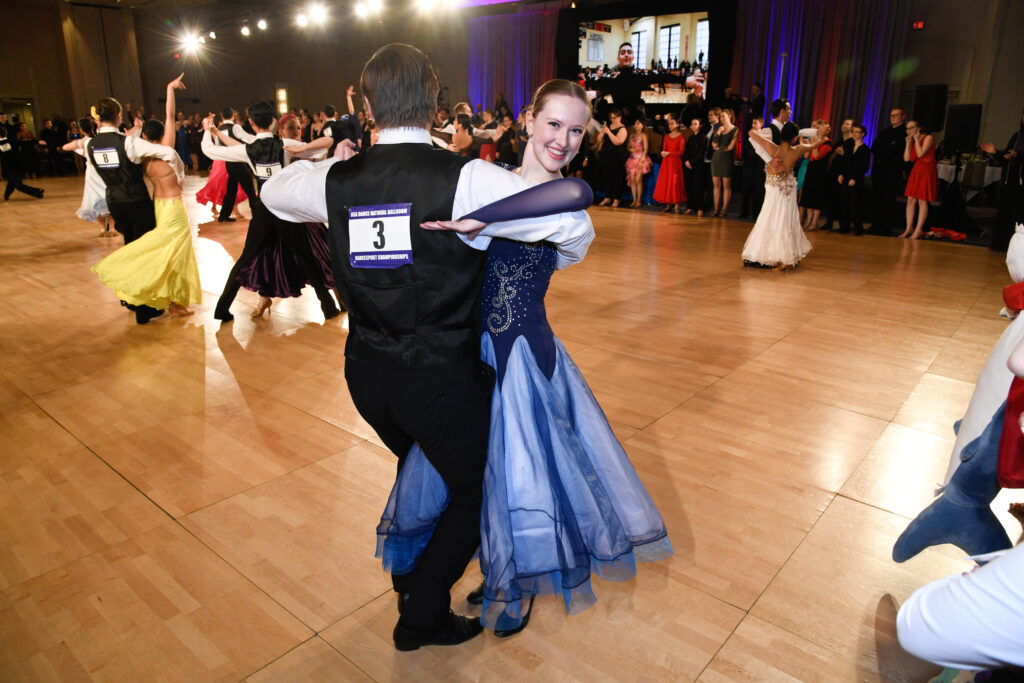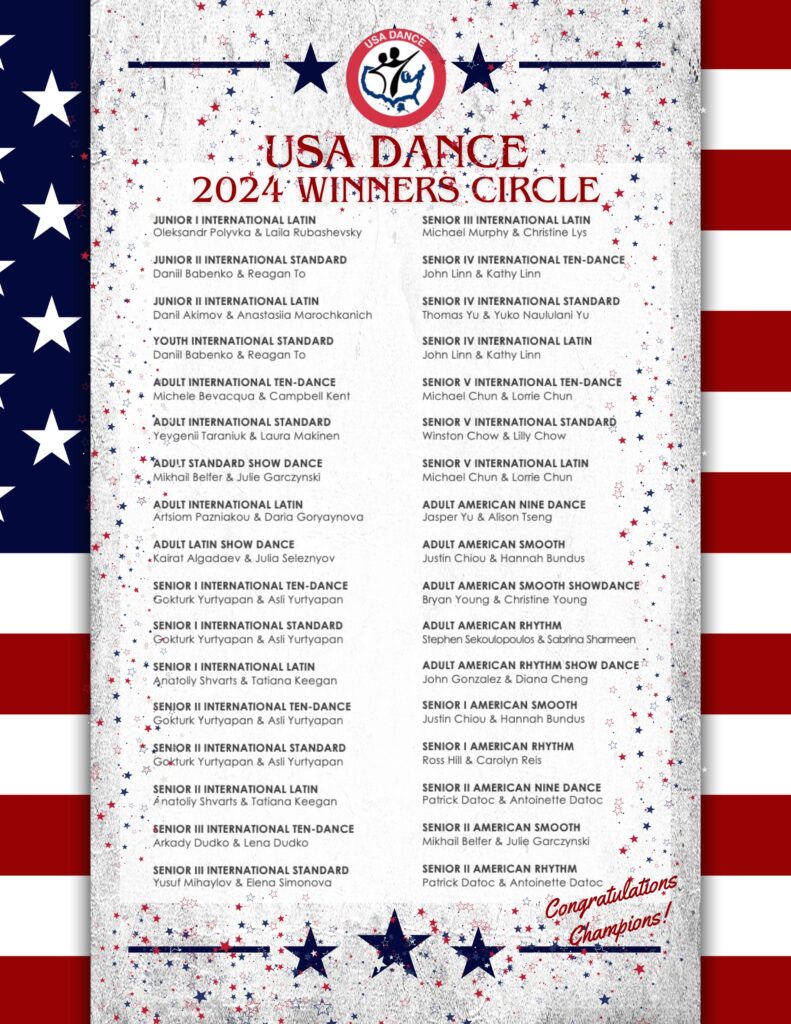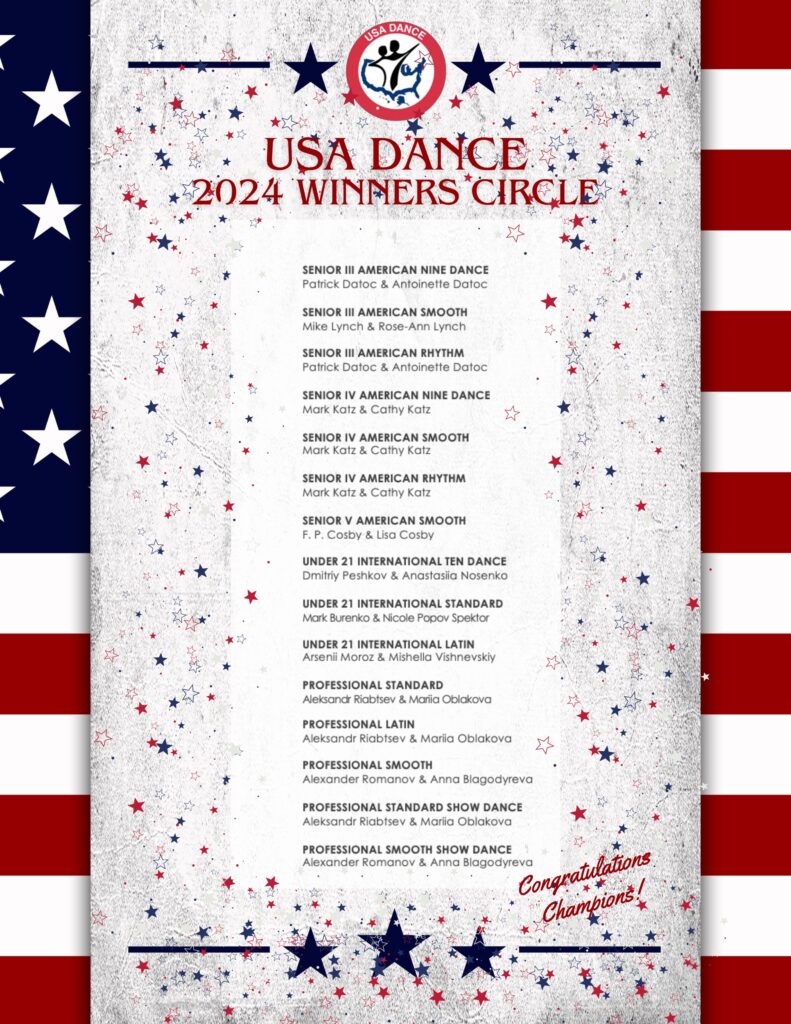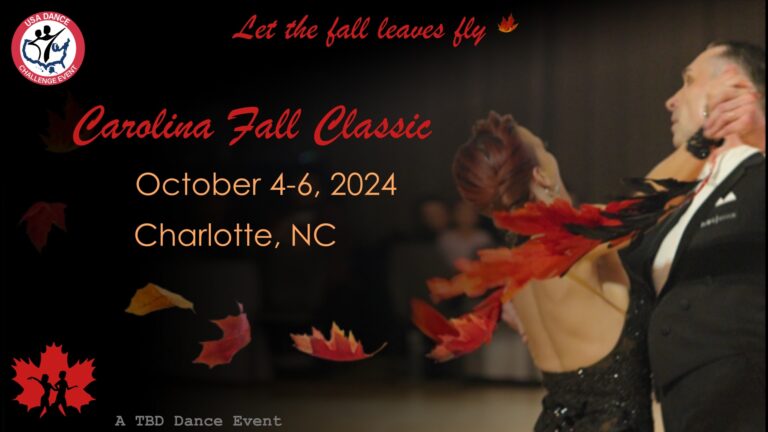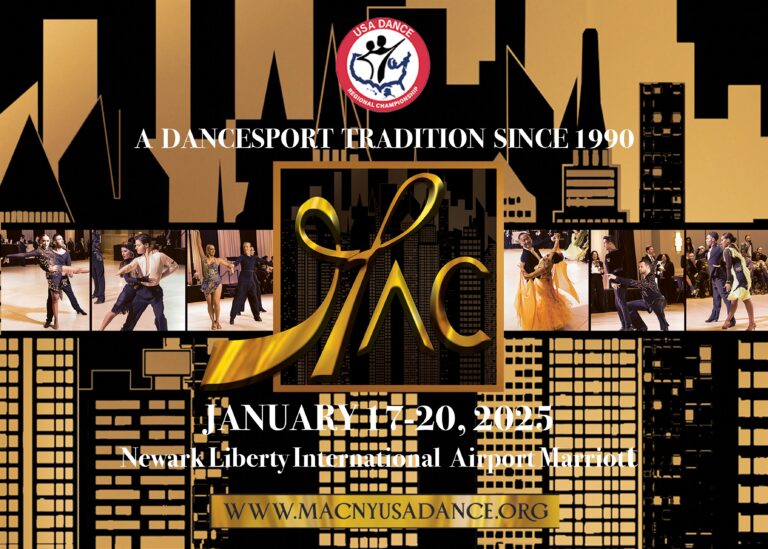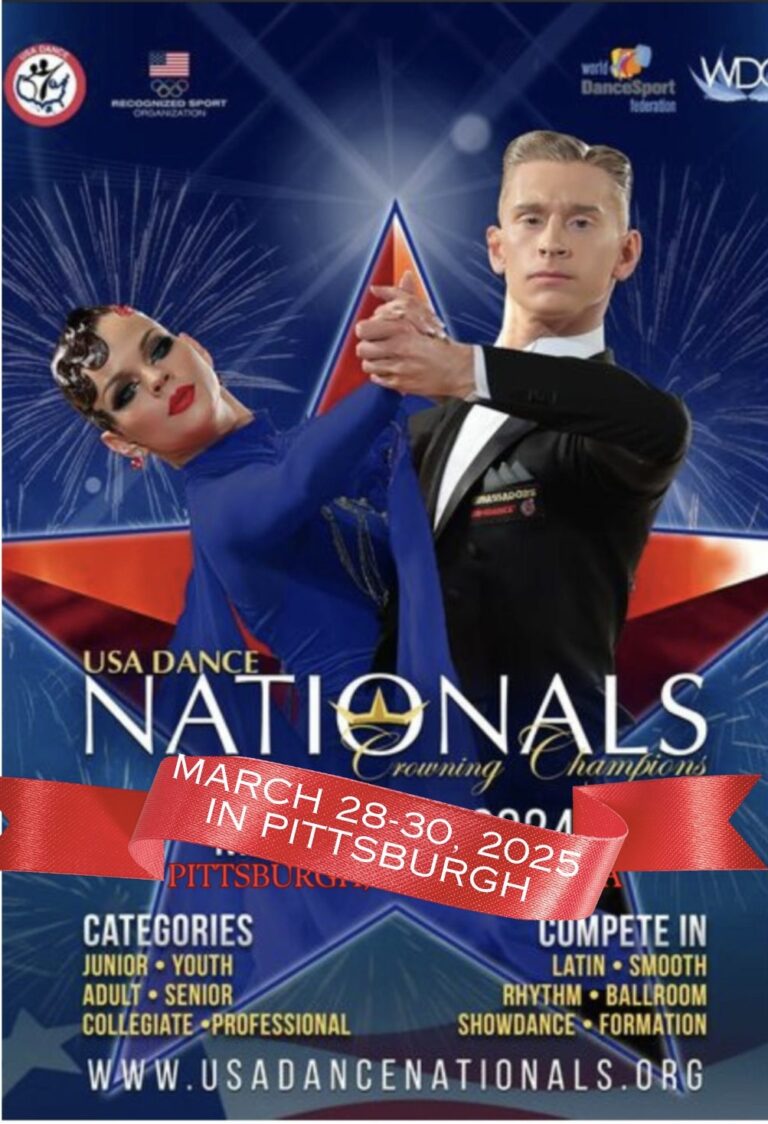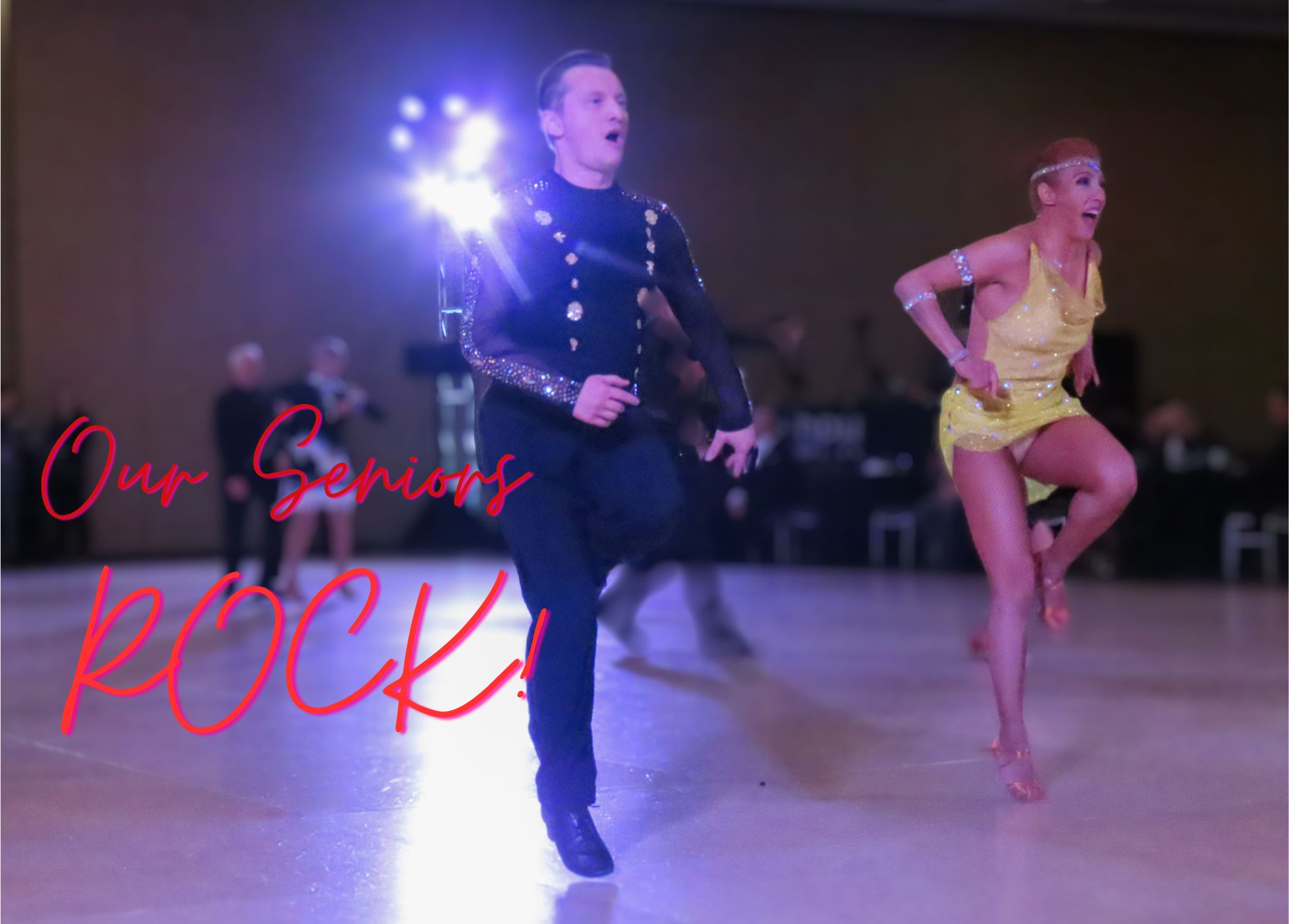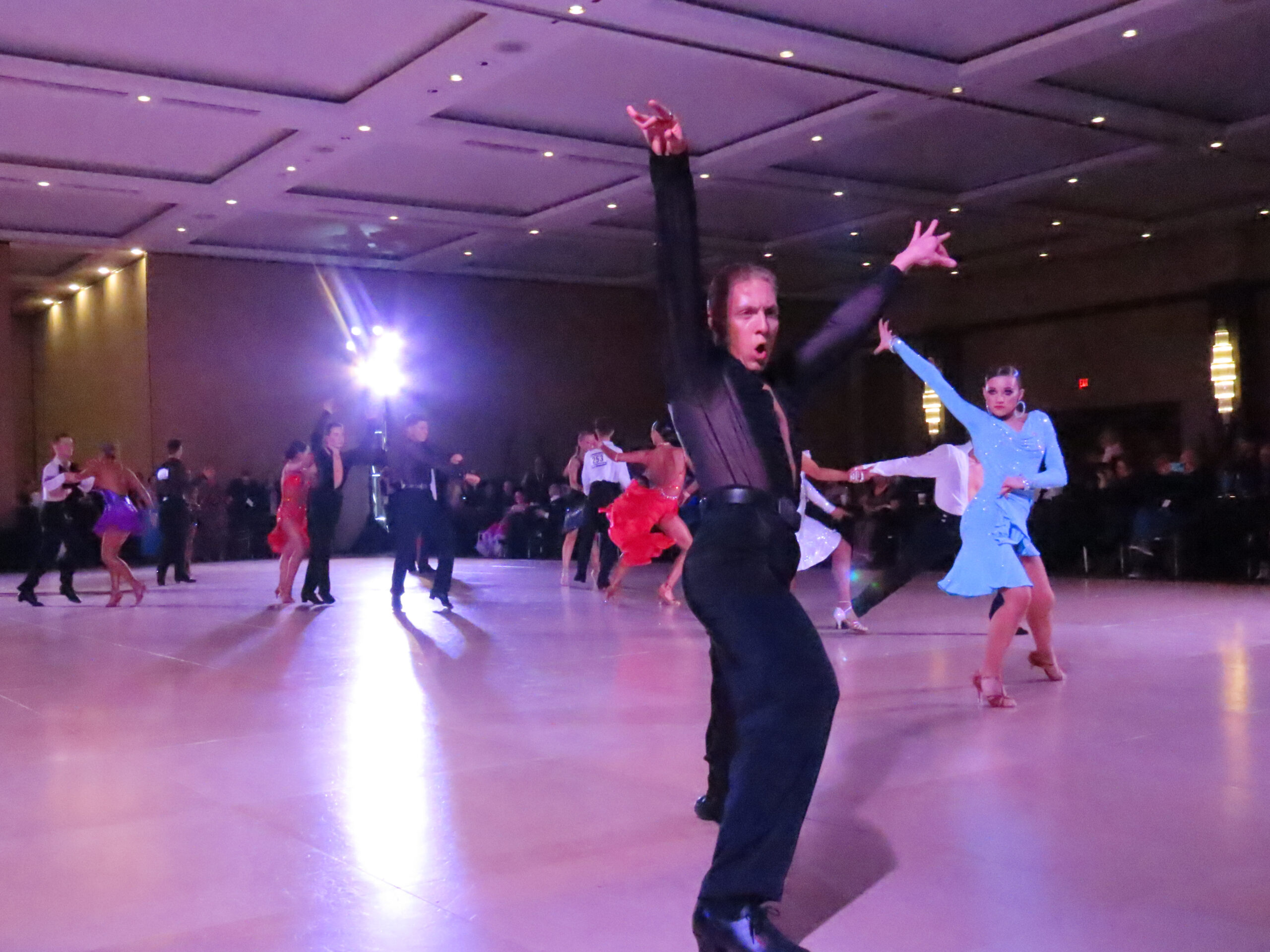USA Dance Nationals will be held in St. Louis, Missouri, March 17-19, 2023. Are you thinking about going, but have never been to a ballroom competition and don’t know what to expect?
American Dancer is happy to reprint this informative piece from past National Collegiate DanceSport Championships (NCDC) Programs. We hope you find it informative. We encourage all USA Dance members, families, friends, and other dance enthusiasts to come out for Nationals and discover the beautiful world of competitive ballroom dancing.
Newcomer’s Guide to Competitive Ballroom Dancing
Ballroom dancing is a competitive sport with specific rules, structures, and judging criteria, but despite that, it can also be a ton of fun! A typical ballroom competition consists of events in various dance styles, age groups, and skill levels. It also involves audience participation, both in dancing as well as in cheering on the competitors.
Dance Styles:
The following styles are danced at most USA Dance DanceSport Competitions:
American Rhythm
- Cha Cha
- Rumba
- Swing
- Bolero
- Mambo
American Smooth
- Waltz
- Tango
- Foxtrot
- Viennese Waltz
International Latin
- Cha Cha
- Samba
- Rumba
- Paso Doble
- Jive
International Standard
- Waltz
- Tango
- Viennese Waltz
- Foxtrot
- Quickstep
International Standard and American Smooth share many technical principles, and many couples compete in both styles. In Standard, the couple remains in closed dance position throughout each dance. In Smooth, they dance in open positions (side-by-side, shadow, etc.) as well as in closed position. Although international Latin and American Rhythm both include Cha Cha and Rumba, each dance style uses different technique and music tempos.
Skill Levels
In ballroom, the term proficiency level is used to describe the expertise with which a given couple performs — a combination of their training, competition experience, and natural talent. Depending on the skill level, dancers will compete in single-dance events (one dance at a time) or multi-dance events (several dances in a row). As the skill level increases, so do the number of dances available to the dancers.
Newcomer: Some competitions include a Newcomer level, consisting of single-dance events. This provides Newcomers a friendly start to their competition careers.
Syllabus Levels — Bronze, Silver, and Gold: In each dance style, couples generally begin at the Bronze syllabus level and work their way up through Silver and Gold. Each syllabus level has a list of clearly defined dance steps, or figures. Couples competing in a given syllabus are not allowed to perform figures of a higher proficiency level, although couples competing in Silver or Gold usually include certain Bronze figures in their routines.
Open Levels — Novice, Pre-Championship, and Championship: Dancers typically graduate from the syllabus levels and move to the open levels. At the open levels, figure restrictions are lifted, though dancers still use syllabus figures along with original, non-syllabus choreography. Championship is the highest and most competitive level in ballroom dance.
Team Matches
At NCDC, collegiate teams compete in International and American styles, vying for first-place honors and generous scholarship money to help encourage their continued exploration of ballroom dance. Each team consists of three couples, and each couple is assigned a specific dance in their chosen style. The team matches are very loud and exuberant, so find some earplugs and get ready to cheer for your favorite team! These matches have been such a favorite that they often extend beyond the collegiate dancers and include other competitors.
Jack and Jill Events
Jack and Jill events are designed to be fun for everyone! In these dances, couples are paired up randomly and are often judged on enthusiasm as well as technique. Dancers and spectators alike are encouraged to get involved in the Jack and Jill dances. You never know who might take home first place!
Strictly Dances
The Strictly category contains dances not included in the core four styles of American Rhythm, American Smooth, International Latin, and International Standard. These dances include Argentine Tango, Lindy Hop, Salsa, West Coast Swing, etc. These are judged based on the character and technique of each dance, which can be very different from the techniques customary in the core four dance styles.
Judging
Judges are certified by various licensing agencies. They are also experienced competitors and instructors. Judging is both an objective and a subjective process. Couples are judged on their technical skill, their interpretation of each dance, and their showmanship. In addition, each adjudicator has his or her own personal standards. For this reason, several adjudicators will judge each event to ensure fairness.
Depending on the number of entries, competitors may be required to compete in a series of elimination rounds until six couples are recalled for the final round by the judges. These six couples will be ranked first through sixth.
Competitor Participation
Dancers compete in heats, which are a specific group of competitors competing in a particular event at a specified time (or times, if there will be callbacks). Typically, dancers will receive a program or heat list to let them know approximately what times they’ll be expected to compete. Dancers should be prepared to compete at least 30 minutes before their scheduled heats in case the competition is running ahead of schedule. When it is time for dancers to compete, they will form a line with their fellow competitors in the designated on-deck area. When their heat is called, they’ll find a spot on the floor and dance until the music stops. They’ll take a bow and exit the floor or proceed to the spot for the start of their next dance. If a heat has a large number of competitors, it is likely there will be a callback process in which the judges select a number of couples to return to the floor and dance again. This process will continue until there are eight or fewer couples (the ideal number is six) remaining on the floor, which will be the final round.
Audience Participation
Many people attending their first ballroom event expect to find the audience sitting in serene dignity, delicately applauding at the completion of each dance. Quite the opposite. The spectators at a ballroom competition are yelling, jumping up and down, and generally carrying on the way they would at any other spectator sport. Ballroom dancers thrive on audience appreciation. E ven if you don’t know the first thing about ballroom, you still have an important role to play at an event. Audience participation is not only allowed but is encouraged and welcomed. Cheer, applaud, and call out the numbers of your favorite couples. Being an active spectator ensures that you’ll have a great time!
Thank you to the NCDC for allowing the use of this piece.
USA Dance Nationals is an exciting event and will feature dancers of all ages (4-94 or more) and levels (Bronze to Championship). Are you considering a trip to St. Louis? Perhaps you should…the Ballroom Floor is Calling!!!

